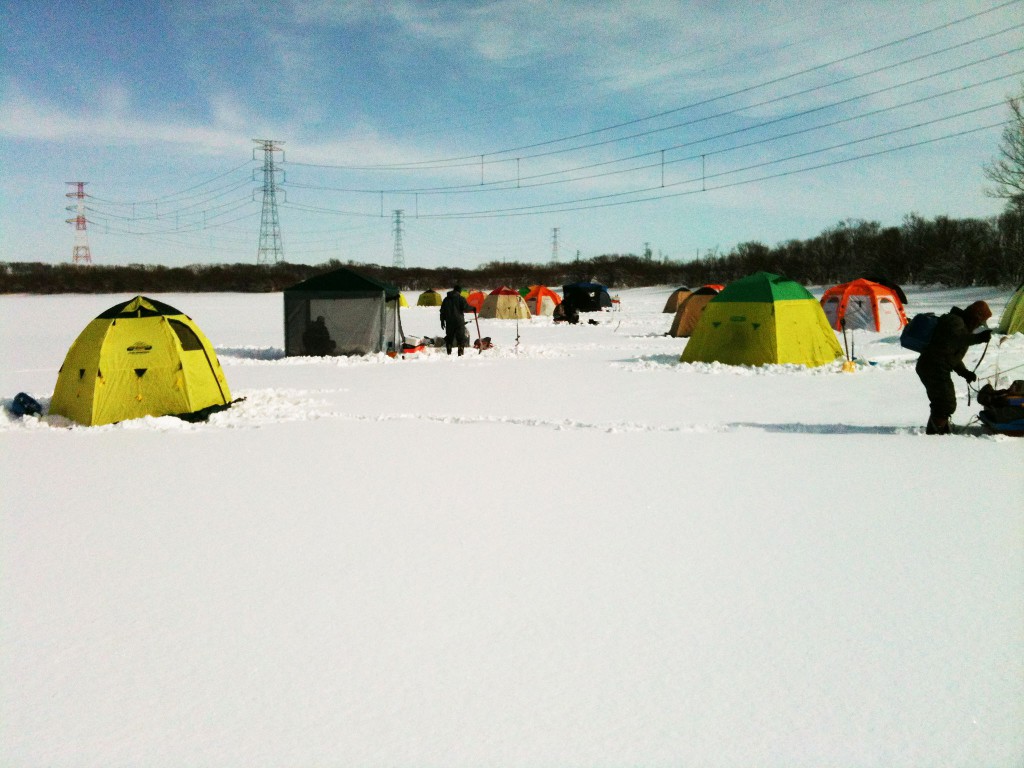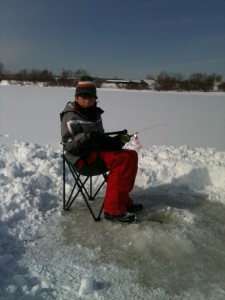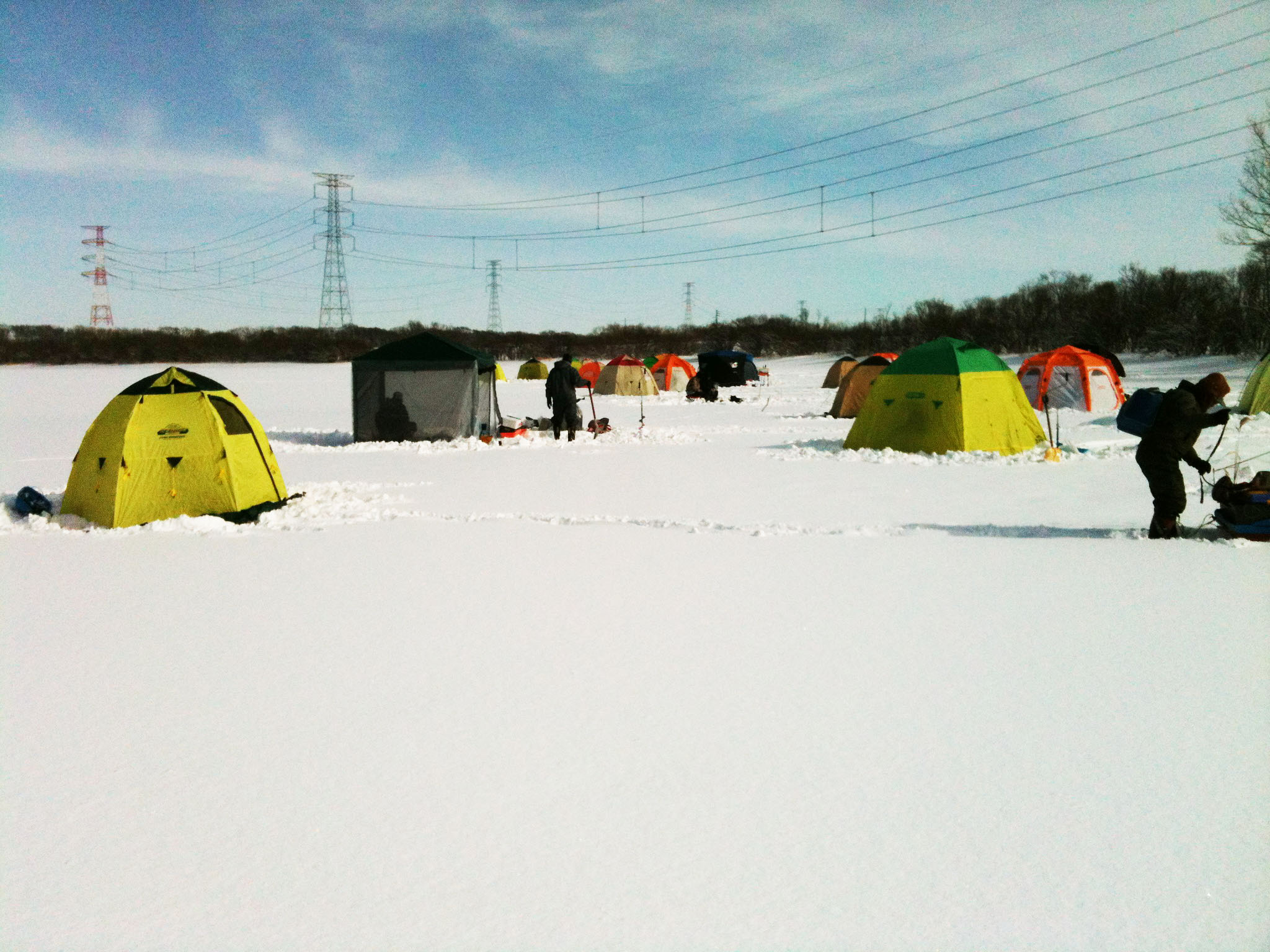Explorer’s Journal: Ice Fishing on the Ishikari

By Raphael Seccombe
One cold February morning, my family was invited ice fishing by a neighboring Japanese family. The father of the family is an experienced ice fisher. He had been many times before, and often went out with friends for an evening. He had all the essential equipment. On the other hand, it was my family’s first time. My father had frantically been out to the shops the night before, trying to buy all that he thought we needed. He could only find cheap and cheerful plastic rods. All the other choices were expensive professional equipment.
As we arrived, we saw that many other fishers’ tents had been set up across the frozen, snow-covered river. There was no wind, so each tent had its flaps open, and we could see inside. The fishers were all gathered around holes in the ice, fishing.
We chose a spot randomly amongst the vast expanse. We still made sure that our location was near some of the other tents. Here the Japanese father pulled out the first of his secret weapons — a drill. It was portably folded. Its shape resembled something more or less like an Archimedes’ screw. He showed us how to plug this in the ice, twist it, and screw-dig a hole. As the screw reached the bottom of the ice, the water level rose and came gushing out like a pump, but soon calmed down and reverted to surface level — par with the top of the ice. The ice was a good 10 to 15 centimeters thick. We were within the vicinity of the bank, but we were told that further out towards the center of the river the ice wasn’t as safe.
The next magic tool was a sieve on a short wooden pole. With this he lifted out all the remaining slushy ice that was in the water. The water was freezing cold, so if we touched it with our gloves, they would freeze in a matter of minutes.
Now that our holes had been made, we had to bait the lines. The Japanese father had brought a bag of little maggot-like bugs — apparently the best kind of bait. For ice-fishing, it was best to have multiple hooks on your line. However, this meant that we had to bait about 50 hooks total for the five rods we had brought. This required taking off our gloves in the frigid morning air.
Finally we were ready to fish. As my siblings went off to drill more holes, I quietly sat down on a camp-chair with my line and let it drop into the water. The best tactic here was to let your line sink right to the bottom and then wind it up slightly. The fish all lived on the riverbed. Dangling your bait just above them would catch the most fish.

It was only a matter of minutes before we started catching fish. Soon we had five or six in our little bucket. I didn’t seem to be catching any, so I pulled my line up to discover that my dad hadn’t baited it very well and only one of the ten hooks had bait left on it. After a short baiting session I was back in business, and as the morning continued, the population of our little bucket expanded to a good 50 or more.
This is where a little Japanese culture stepped in. My mother and the Japanese mother both pulled out a pan and a little stove. In little pots they had also both brought batter. The pans were filled with oil and then heated up on the stove. The poor little fish, most of whom were still alive, were dipped in the batter and then plopped in the burning oil, where they wriggled for half a second before sizzling happily. When they were done, they were placed on a plate and sprinkled with salt. Tempura fish. I was the first to try one and they were delicious, tasting rather like hot chips. Two of my siblings refused to eat them, much to their loss, I thought. The other one finally gave in and tried one, and then couldn’t stop as she finished off the rest on the plate almost immediately.
One of the major villains of the day was the cold. It was minus 10 or 12 degrees celsius. I got so cold that I had to start walking around and keep moving in order to stay warm. At two in the afternoon, the warmest time of day, the temperature was still a good five degrees below freezing.
What saved us in these temperatures was the Japanese ‘kairo’ (カイロ). These are little paper-ish bags half the size of your hand. When you shake them, due to some chemical reaction, they start warming up. These performed miracles on our hands, feet, and necks, as long as we moved them every now and then.
Overall, it was an enjoyable though cold trip. The cold weather only made the tempura more satisfying. Although we went for a day-trip, I would have preferred going for only a morning or an afternoon. A full day of ice fishing is rather long. If you consider going for your first time as well, I would advise going along with someone who has been before — it is always nice to have someone with you who knows what they are doing.
Essentials for Ice Fishing:
snow gear
a sled to carry everything in
a tent, preferably floorless, so you can fish from inside
a drill*
a special sieve*
rods (and hooks)*
bait*
bucket
tempura cooking gear: camping-stove, pan, pre-prepared batter, plate, salt
kairos
*All of these should be available at a fishing store.




